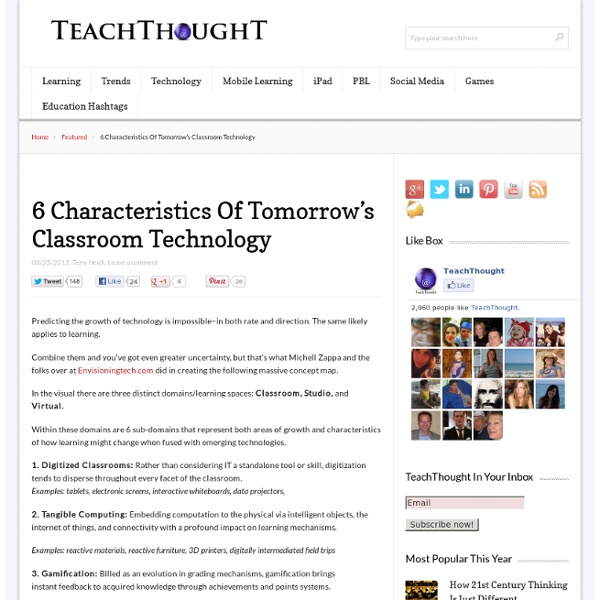6 Characteristics Of Tomorrow's Classroom Technology

10 Techy Icebreakers for The 21st Century Teacher
Here are some great icebreakers you can work on using technology : 1- Self PortraitHave your students draw themselves. After they have done this, collect the papers and hang them up for the whole class to see. 2- Video/ audio introductions Encourage students to record a short video clip in which they introduce themselves to their peers. The teacher generates a list of words related to a topic to be taught. 5- Prior Knowledge check Giving multiple choice tests or true and false quizzes before introducing a topic or reading engages students, activates a student’s prior knowledge, and will encourage the sharing of information and resources. 6- Personalize it Teacher writes the topic to be taught on the board and then talks about how the topic relates to them by using a personal reference or story.
The 7 Most Powerful Ideas In Learning Available Right Now
Tomorrow’s Learning Today: 7 Shifts To Create A Classroom Of The Future by Terry Heick For professional development around this idea or others you read about on TeachThought, contact us. Let’s take a look at the nebulous idea of the “classroom of the future.” This is all subjective, but it’s worth talking about. So let’s talk. Below are some ideas that are truly transformational–not that they haven’t been said before. And the best part? But therein lies the rub: Tomorrow’s learning is already available, and below are 7 of the most compelling and powerful trends, concepts, and resources that represent its promise. The Challenge of Implementation It’s challenging enough to manage a traditional learning environment where the curriculum is handed to you, and meetings are set, and you’re simply there to manage; adding more ingredients to the mix seems like asking for trouble. None of it is really complicated—it just requires new thinking. Tomorrow’s Learning Today: 7 Shifts Of Future Learning 1.
Implicit Learning: Researchers Uncover How to Learn Without Trying
It’s rare that a computer science lab brings us a scenario worthy of a spy novel, but that’s what happened earlier this month when Hristo Bojinov, a researcher at Stanford University, divulged his latest project. Here’s the setup: Imagine an operative has been entrusted with top-secret computer files. He needs a password to enable him to access the information — but what if he falls into the hands of the enemy, and they force him to reveal the code? Bojinov and his colleagues concocted the perfect solution: a password that the spy could use any time he needed it, but which was not available to his conscious mind. (MORE: Born to Be Bright: Is There a Gene for Learning?) As cloak-and-dagger as it sounds, the technique the Stanford scientists have developed takes advantage of a common phenomenon known as implicit learning. Although the rest of us don’t have access to Bojinov’s technology, there are ways to improve our implicit learning. (MORE: Can You Learn Everything “On the Job”?)
Augmented Reality: Coming Soon to a School Near You?
Digital Tools Teaching Strategies In “Dow Day,” an augmented reality game, middle school students walk the University of Wisconsin-Madison campus using mobile phones to view footage of Vietnam war protests that occurred in the same campus locations. By Sarah Jackson David Gagnon is talking to a group of educators about how to use mobile devices for learning. In his work as an instructional designer with the University of Wisconsin’s ENGAGE program, Gagnon has given this workshop many times. But these days, he says, things are starting to change. “How many of you are currently using an iPhone, iPad, or iPod touch?” What happens next demonstrates how the availability of communications technology has grown exponentially in recent years: 89 percent of this group owns a mobile device, and they want to know how to use it in their classrooms. “Two years ago, when we would do a workshop with 20 people, we would have to bring 10 devices. Gagnon and his team may be able to help. Jim Mathews Related
Related:
Related:



